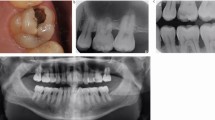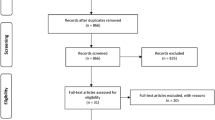Abstract
Data sources
Medline and the Igaku Chuo Zasshi (Japanese) databases, the reference list of identified studies and personal reprint collections of authors were searched.
Study selection
Randomised controlled trials (RCT), controlled clinical trials (CCT) and case series conducted in permanent teeth were included.
Data extraction and synthesis
Two independent reviewers extracted the data using specially designed forms. A qualitative synthesis is presented.
Results
Ten English and three Japanese studies were finally included (two RCTs, five CCTs and six case series).
Conclusions
From this review, stepwise excavation can be concluded as effective for pulp preservation in extremely deep caries where there are no clinical symptoms of irreversible pulpitis. Calcium hydroxide and other materials, such as antimicrobials and polycarboxylate cement combined with tannin fluoride preparation, have been shown to be effective in reducing bacteria after stepwise excavation. Further clinical trials with high levels of study design in this research field are needed to identify the best possible methods for removing carious dentine during stepwise excavation.
Similar content being viewed by others
Log in or create a free account to read this content
Gain free access to this article, as well as selected content from this journal and more on nature.com
or
References
Wicht MJ, Haak R, Schutt-Gerowitt H, Kneist S, Noack MJ . Suppression of caries-related microorganisms in dentine lesions after short-term chlorhexidine or antibiotic treatment. Caries Res 2004; 38: 436–441.
Leksell E, Ridell K, Cvek M, Mejáre I . Pulp exposure after stepwise versus direct complete excavation of deep carious lesions in young posterior permanent teeth. Endod Dent Traumatol 1996; 12: 192–196.
Gluud LL . Bias in clinical intervention research. Am J Epidemiol 2006; 163: 493–501.
Bjørndal L, Reit C, Bruun G, et al. Treatment of deep caries lesions in adults: randomized clinical trials comparing stepwise vs. direct complete excavation, and direct pulp capping vs. partial pulpotomy. Eur J Oral Sci 2010; 118: 290–297.
Wetterslev J, Thorlund K, Brok J, Gluud C . Trial sequential analysis may establish when firm evidence is reached in cumulative meta-analysis. J Clin Epidemiol 2008; 61: 64–75.
Brok J, Thorlund K, Gluud C, Wetterslev J . Trial sequential analysis reveals insufficient information size and potentially false positive results in many meta-analyses. J Clin Epidemiol 2008; 61: 763–769.
Author information
Authors and Affiliations
Additional information
Address for correspondence: Mikako Hayashi, Department of Restorative Dentistry and Endodontology, Osaka University Graduate School of Dentistry, 1–8 Yamadaoka, Suita 565–0871, Japan. E-mail: mikarin@dent.osaka-u.ac.jp
Hayashi M, Fujitani M, Yamaki C, Momoi Y. Ways of enhancing pulp preservation by stepwise excavation – a systematic review. J Dent 2011; 39: 95–107.
Rights and permissions
About this article
Cite this article
Bjørndal, L. In deep cavities stepwise excavation of caries can preserve the pulp. Evid Based Dent 12, 68 (2011). https://doi.org/10.1038/sj.ebd.6400803
Published:
Issue date:
DOI: https://doi.org/10.1038/sj.ebd.6400803
This article is cited by
-
Knowledge and attitudes toward evidence-based cariology and restorative dentistry among Egyptian dental practitioners: a cross-sectional survey
BMC Oral Health (2023)
-
Dentists’ attitudes and behaviour regarding deep carious lesion management: a multi-national survey
Clinical Oral Investigations (2017)
-
Stahlkronen
Der Freie Zahnarzt (2013)



